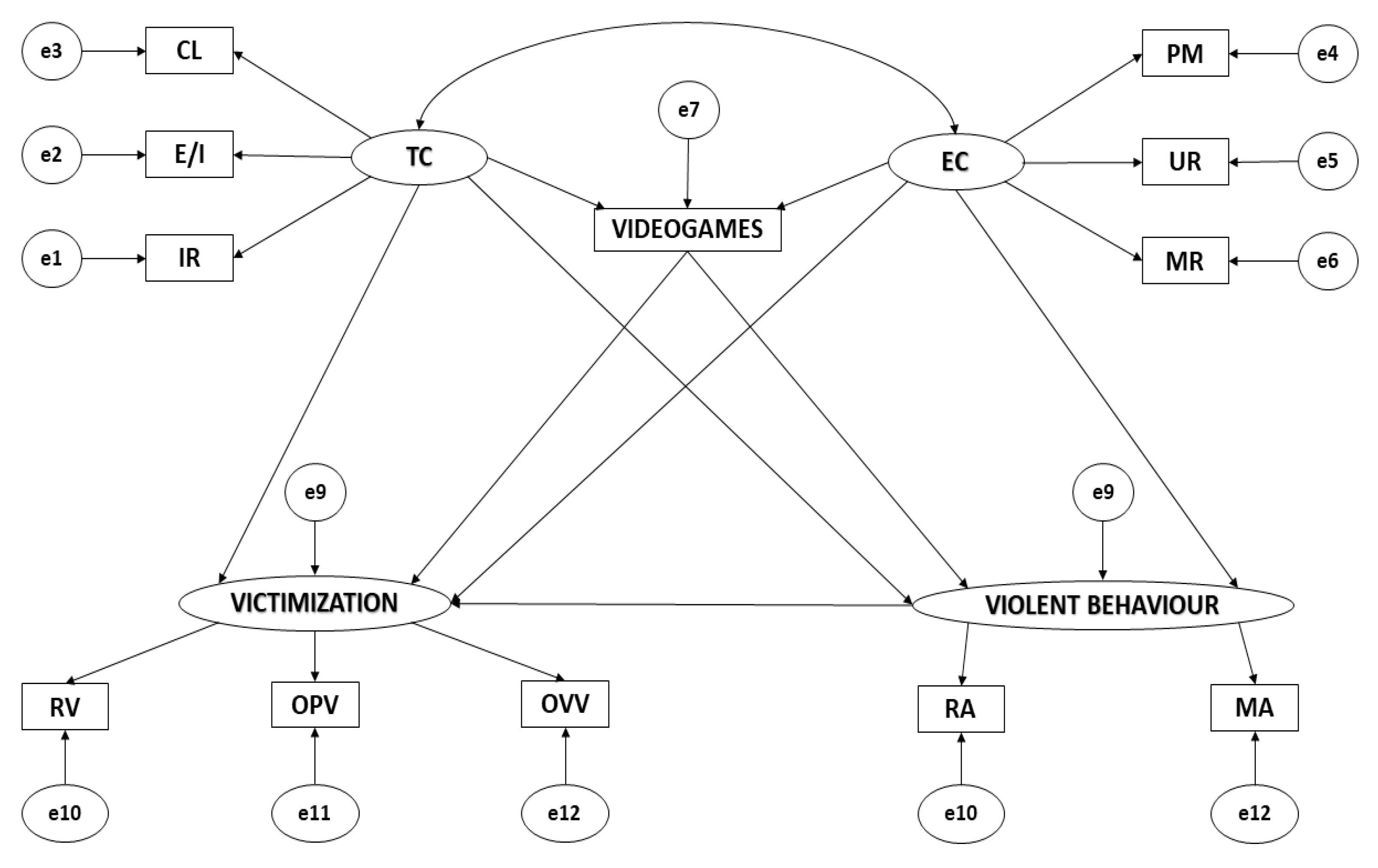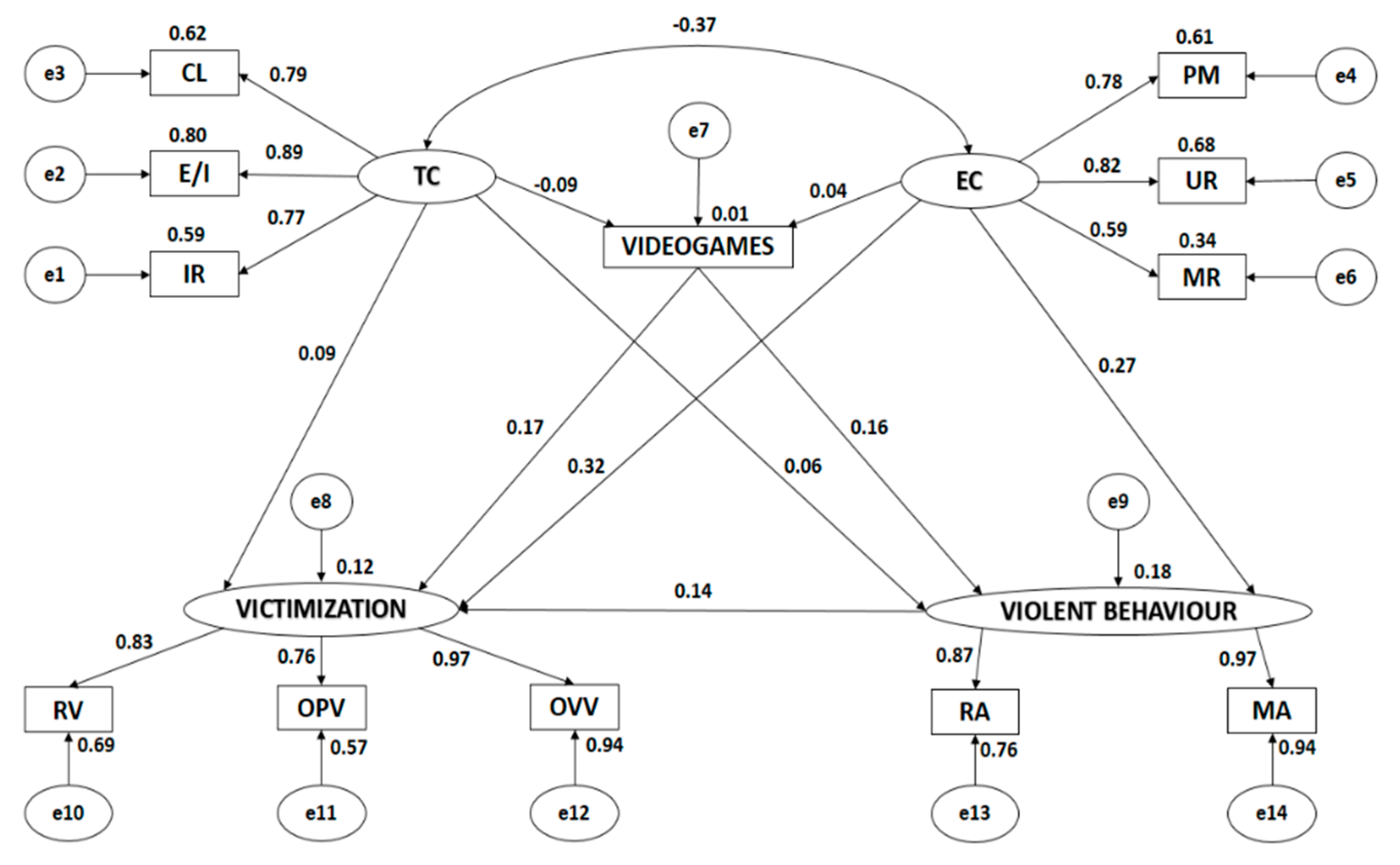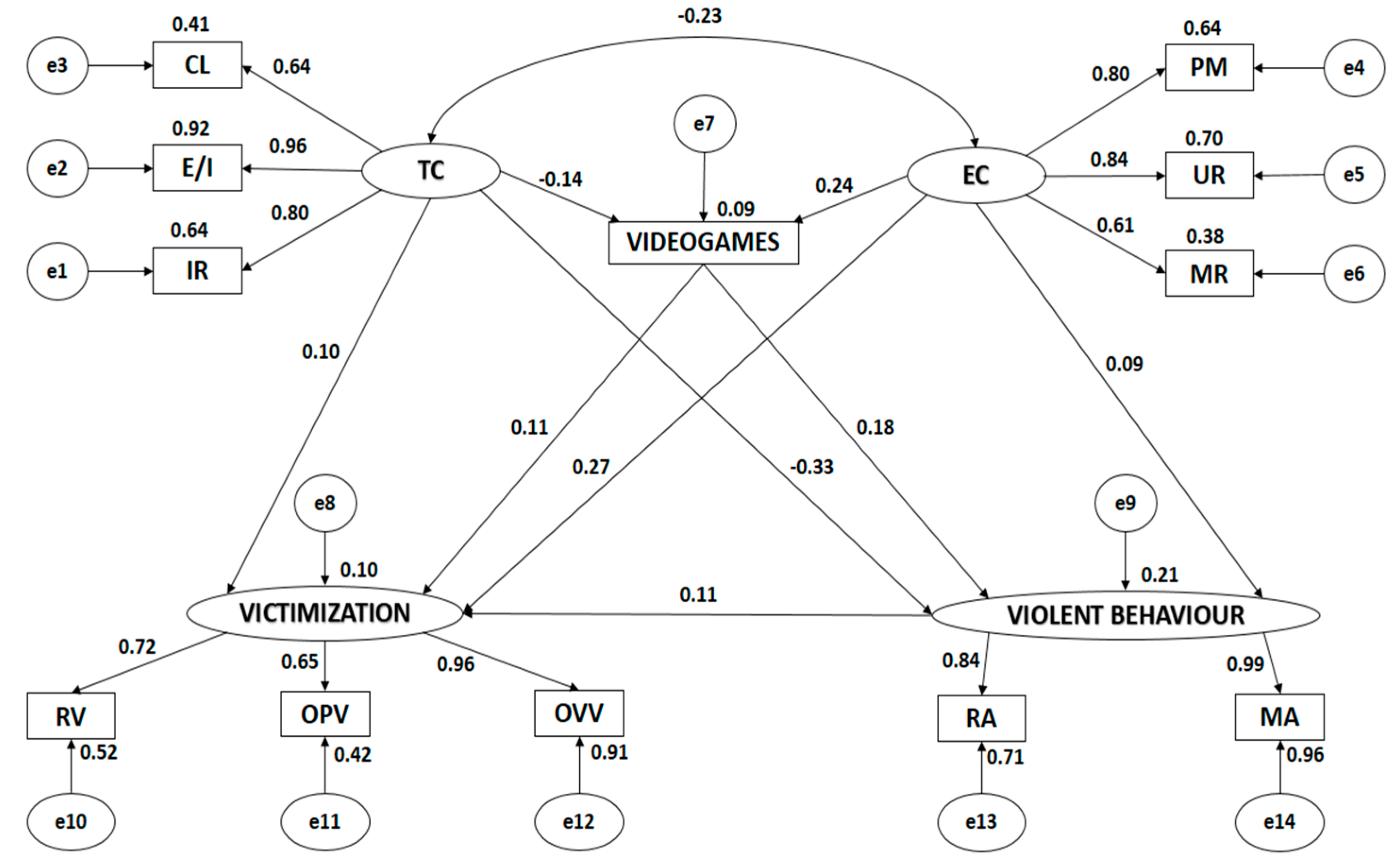Motivational Climate Is Associated with Use of Video Games and Violence in Schoolchildren: A Structural Equation Model According to Healthy Behaviors
Abstract
:1. Introduction
2. Materials and Methods
2.1. Design and Participants
2.2. Variables and Instruments
2.3. Procedure
2.4. Data Analysis
3. Results
4. Discussion
5. Conclusions
Author Contributions
Funding
Conflicts of Interest
References
- Anderson, E.L.; Steen, E.; Stavropoulos, V. Internet use and problematic internet use: A systematic review of longitudinal research trends in adolescence and emergent adulthood. Int. J. Adol. Youth 2017, 22, 430–454. [Google Scholar] [CrossRef] [Green Version]
- Krossbakken, E.; Torsheim, T.; Mentzoni, R.A.; King, D.L.; Bjorvatn, B.; Lorvik, I.M.; Pallesen, S. The effectiveness of a parental guide for prevention of problematic video gaming in children: A public health randomized controlled intervention study. J. Behav. Addict. 2018, 7, 52–61. [Google Scholar] [CrossRef] [PubMed]
- Shi, J.; Boak, A.; Mann, R.; Turner, N.E. Adolescent problem video gaming in urban and non-urban regions. Int. J. Ment. Health Addict. 2018, 17, 817–827. [Google Scholar] [CrossRef] [Green Version]
- Van Rooij, A.J.; Schoenmakers, T.M.; Van de Mheen, D. Clinical validation of the C-VAT 2.0 assessment tool for gaming disorder: A sensitivity analysis of the proposed DSM-5 criteria and the clinical characteristics of young patients with ‘video game addiction’. Addict. Behav. 2017, 64, 269–274. [Google Scholar] [CrossRef]
- Verheijen, G.P.; Burk, W.J.; Stoltz, S.E.; van den Berg, Y.H.; Cillessen, A.H. Friendly fire: Longitudinal effects of exposure to violent video games on aggressive behavior in adolescent friendship dyads. Aggress. Behav. 2018, 44, 257–267. [Google Scholar] [CrossRef] [Green Version]
- Carras, M.C.; Van Rooij, A.J.; Van de Mheen, D.; Musci, R.; Xue, Q.L.; Mendelson, T. Video gaming in a hyperconnected world: A cross-sectional study of heavy gaming, problematic gaming symptoms, and online socializing in adolescents. Comput. Hum. Behav. 2017, 68, 472–479. [Google Scholar] [CrossRef] [Green Version]
- Hinkley, T.; Salmon, J.O.; Okely, A.D.; Crawford, D.; Hesketh, K. Preschoolers’ physical activity, screen time, and compliance with recommendations. Med. Sci. Sport Exerc. 2012, 44, 458–465. [Google Scholar] [CrossRef]
- Lau, C.; Stewart, S.L.; Sarmiento, C.; Saklofske, D.H.; Tremblay, P.F. Who is at risk for problematic video gaming? Risk factors in problematic video gaming in clinically referred canadian children and Adolescents. Mult. Technol. Interact. 2018, 2, 19. [Google Scholar] [CrossRef] [Green Version]
- Greitemeyer, T. The spreading impact of playing violent video games on aggression. Comput. Hum. Behav. 2018, 80, 216–219. [Google Scholar] [CrossRef]
- Szycik, G.R.; Mohammadi, B.; Hake, M.; Kneer, J.; Samii, A.; Münte, T.F.; Te Wildt, B.T. Excessive users of violent video games do not show emotional desensitization: An fMRI study. Brain Imaging Behav. 2017, 11, 736–743. [Google Scholar] [CrossRef]
- Adachi, P.J.; Willoughby, T. The link between playing video games and positive youth outcomes. Child Dev. Perspect. 2017, 11, 202–206. [Google Scholar] [CrossRef]
- Kimmig, A.C.; Andringa, G.; Derntl, B. Potential adverse effects of violent video gaming: Interpersonal-affective traits are rather impaired than disinhibition in young adults. Front. Psychol. 2018, 9, 736–747. [Google Scholar] [CrossRef] [PubMed] [Green Version]
- Cui, J.; Lee, C.; Bax, T. A comparison of ‘psychosocially problematic gaming’ among middle and high school students in China and South Korea. Comput. Hum. Behav. 2018, 85, 86–94. [Google Scholar] [CrossRef]
- Lewis, B.A.; Napolitano, M.A.; Buman, M.P.; Williams, D.M.; Nigg, C.R. Future directions in physical activity intervention research: Expanding our focus to sedentary behaviors, technology, and dissemination. J. Behav. Med. 2017, 40, 112–126. [Google Scholar] [CrossRef] [PubMed] [Green Version]
- Gillison, F.B.; Standage, M.; Cumming, S.P.; Zakrzewski-Fruer, J.; Rouse, P.C.; Katzmarzyk, P.T. Does parental support moderate the effect of children’s motivation and self-efficacy on physical activity and sedentary behaviour? Psychol. Sport Exerc. 2017, 32, 153–161. [Google Scholar] [CrossRef]
- Clark, H.; Camiré, M.; Wade, T.J.; Cairney, J. Sport participation and its association with social and psychological factors known to predict substance use and abuse among youth: A scoping review of the literature. Int. Rev. Sport Exerc. Psychol. 2015, 8, 224–250. [Google Scholar] [CrossRef]
- Sommet, N.; Elliot, A.J. Achievement goals, reasons for goal pursuit, and achievement goal complexes as predictors of beneficial outcomes: Is the influence of goals reducible to reasons? J. Educ. Psychol. 2017, 109, 1141–1162. [Google Scholar] [CrossRef] [Green Version]
- Lochbaum, M.; Kallinen, V.; Konttinen, N. Task and ego goal orientations across the youth sports experience. Stud. Sport. 2017, 11, 99–105. [Google Scholar] [CrossRef] [Green Version]
- Gjesdal, S.; Haug, E.M.; Ommundsen, Y. A conditional process analysis of the coach-created mastery climate, task goal orientation, and competence satisfaction in youth soccer: The moderating role of controlling coach behavior. J. Appl. Sport Psychol. 2019, 31, 203–217. [Google Scholar] [CrossRef]
- Ring, C.; Kavussanu, M. The impact of achievement goals on cheating in sport. Psychol. Sport Exerc. 2018, 35, 98–103. [Google Scholar] [CrossRef] [Green Version]
- Chamarro, A.; Carbonell, X.; Manresa, J.M.; Muñoz-Mirallles, R.; Ortega-González, R.; López-Morrón, M.R.; Batalla-Martínez, C.; Torán-Monserrat, P. El Cuestionario de Experiencias Relacionadas con los Videojuegos (CERV): Un instrumento para detectar el uso problemático de videojuegos en adolescentes españoles. Adicciones 2014, 26, 303–311. [Google Scholar] [CrossRef] [PubMed] [Green Version]
- Mynard, H.; Joseph, S. Development of the multidimensional peer-victimisation scale. Aggress. Behav. 2000, 26, 169–178. [Google Scholar] [CrossRef]
- Cava, M.J.; Musitu, G.; Murgui, S. Individual and social risk factors related to overt victimisation in a sample of Spanish adolescents. Psychol. Rep. 2007, 101, 275–290. [Google Scholar] [CrossRef] [PubMed] [Green Version]
- Povedano, A.; Estévez, E.; Martínez, B.; Monreal, M.C. A psychosocial profile of adolescent aggressors and school victims: Analysis of gender differences. Rev. Psicol. Soc. 2012, 27, 169–182. [Google Scholar] [CrossRef]
- Little, T.D.; Henrich, C.C.; Jones, S.M.; Hawley, P.H. Disentangling the “whys” from the “whats” of aggressive behaviour. Int. J. Behav. Dev. 2003, 27, 122–133. [Google Scholar] [CrossRef]
- Estévez, E. Violence, Victimization and School Rejection in Adolescence; Servei de Publicacions: Valencia, Spain, 2005. [Google Scholar]
- Musitu, G.; Estévez, E.; Emler, N. Adjustment problems in the family and school contexts, attitude towards authority and violent behaviour at school in adolescence. Adolescence 2007, 42, 779–794. [Google Scholar]
- Newton, M.; Duda, J.L.; Yin, Z. Examination of the psychometric properties of the Perceived Motivational Climate in Sport Questionnaire-2 in a sample of female athletes. J. Sport Sci. 2000, 18, 275–290. [Google Scholar] [CrossRef]
- González-Cutre, D.; Sicilia, A.; Moreno, J.A. Modelo cognitivo-social de la motivación de logro en educación física. Psicothema 2008, 20, 642–651. [Google Scholar]
- Marsh, H.W. Handbook of Sport Psychology, 3rd ed.; John Wiley & Sons Inc.: Hoboken, NJ, USA, 2007. [Google Scholar] [CrossRef]
- Brown, C.F.; Demaray, M.K.; Tennant, J.E.; Jenkins, L.N. Cyber victimisation in high school: Measurement, overlap with face-to-face victimisation, and associations with social–emotional outcomes. Sch. Psychol. Rev. 2017, 46, 288–303. [Google Scholar] [CrossRef]
- Castro-Sánchez, M.; Chacón-Cuberos, R.; Ubago-Jiménez, J.; Zafra-Santos, E.; Zurita-Ortega, F. An explanatory model for the relationship between motivation in sport, victimization, and video game use in schoolchildren. Int. J. Environ. Res. Public Health 2018, 15, 1866. [Google Scholar] [CrossRef] [Green Version]
- Chacón-Cuberos, R.; Castro-Sánchez, M.; González-Campos, G.; Zurita-Ortega, F. Victimization in school, digital leisure and irritability: Analysis using structural equations. Relieve 2018, 24, art. 3. [Google Scholar] [CrossRef] [Green Version]
- Yang, C.; Sharkey, J.D.; Reed, L.A.; Chen, C.; Dowdy, E. Bullying victimisation and student engagement in elementary, middle, and high schools: Moderating role of school climate. Sch. Psychol. Quart. 2018, 33, 54. [Google Scholar] [CrossRef]
- Breske, M.P.; Fry, M.D.; Fry, A.C.; Hogue, C.M. The effects of goal priming on cortisol responses in an ego-involving climate. Psychol. Sport Exerc. 2017, 32, 74–82. [Google Scholar] [CrossRef]
- Kramer, A.F.; Colcombe, S. Fitness effects on the cognitive function of older adults: A meta-analytic study. Perspect. Psychol. Sci. 2018, 13, 213–217. [Google Scholar] [CrossRef] [PubMed] [Green Version]
- Arbour-Nicitopoulos, K.P.; Grassmann, V.; Orr, K.; McPherson, A.C.; Faulkner, G.E.; Wright, F.V. A scoping review of inclusive out-of-school time physical activity programs for children and youth with physical disabilities. Adapt. Phys. Act. Q. 2018, 35, 111–138. [Google Scholar] [CrossRef] [PubMed] [Green Version]
- Rhodes, R.E.; Lim, C. Promoting parent and child physical activity together: Elicitation of potential intervention targets and preferences. Health Educ. Behav. 2018, 45, 112–123. [Google Scholar] [CrossRef]
- Fontana, M.S.; Fry, M.D.; Cramer, E. Exploring the relationship between athletes’ perceptions of the motivational climate to their compassion, self-compassion, shame, and pride in adult recreational sport. Measur. Phys. Educ. Exerc. Sci. 2017, 21, 101–111. [Google Scholar] [CrossRef] [Green Version]
- O’Rourke, D.J.; Smith, R.E.; Punt, S.; Coppel, D.B.; Breiger, D. Psychosocial correlates of young athletes’ self-reported concussion symptoms during the course of recovery. Sport Exerc. Perform. Psychol. 2017, 6, 262–276. [Google Scholar] [CrossRef]
- Kenney, E.L.; Gortmaker, S.L. United States adolescents’ television, computer, videogame, smartphone, and tablet use: Associations with sugary drinks, sleep, physical activity, and obesity. J. Pediat. 2017, 182, 144–149. [Google Scholar] [CrossRef] [Green Version]
- Showell, N.N.; Cole, K.W.; Johnson, K.; DeCamp, L.R.; Bair-Merritt, M.; Thornton, R.L. Neighbourhood and parental influences on diet and physical activity behaviors in young low-income paediatrics patients. Clin. Pediatr. 2017, 56, 1235–1243. [Google Scholar] [CrossRef] [Green Version]
- Mazzone, A.; Nocentini, A.; Menesini, E. Bullying and peer violence among children and adolescents in residential care settings: A review of the literature. Aggress. Violent Behav. 2017, 38, 101–112. [Google Scholar] [CrossRef]
- Matthews, C.R.; Channon, A. Understanding sports violence: Revisiting foundational explorations. Sport Soc. 2017, 20, 751–767. [Google Scholar] [CrossRef] [Green Version]
- Graupensperger, S.A.; Jensen, C.J.; Evans, M.B. A meta-analytic review of studies using the Prosocial and Antisocial Behavior in Sport Scale: Associations among intergroup moral behaviors. Sport Exerc. Perform. Psychol. 2018, 7, 186–204. [Google Scholar] [CrossRef]
- Lodewyk, K.R. Associations between university students’ personality traits and victimisation and its negative affect in school physical education. J. Phys. Educ. Sport 2018, 18, 937–943. [Google Scholar] [CrossRef]
- Gampell, A.V.; Gaillard, J.C.; Parsons, M.; Fisher, K. Beyond stop disasters 2.0: An agenda for exploring the contribution of video games to learning about disasters. Environ. Hazards 2017, 16, 180–191. [Google Scholar] [CrossRef]
- Long, J.; Liu, T.; Liu, Y.; Hao, W.; Maurage, P.; Billieux, J. Prevalence and correlates of problematic online gaming: A systematic review of the evidence published in chinese. Curr. Addict. Rep. 2018, 5, 359–371. [Google Scholar] [CrossRef]
- Al-Yaaribi, A.; Kavussanu, M. Consequences of prosocial and antisocial behaviors in adolescent male soccer players: The moderating role of motivational climate. Psychol. Sport Exerc. 2018, 37, 91–99. [Google Scholar] [CrossRef] [Green Version]
- Martin, E.M.; Gould, D.; Ewing, M.E. Youth’s perceptions of rule-breaking and antisocial behaviours: Gender, developmental level, and competitive level differences. Int. J. Sport Exer. Psychol. 2017, 15, 64–79. [Google Scholar] [CrossRef]
- Bekiari, A.; Nikolaidou, Z.A.; Hasanagas, N. Typology of motivation and aggression on the basis of social network variables: Examples of complementary and nested behavioral types through conventional statistics. Soc. Netw. 2017, 6, 135–147. [Google Scholar] [CrossRef] [Green Version]
- Deliligka, S.; Bekiari, A. Multi-parametric analysis of aggressive communication and motivation climate in physical education. Psychology 2018, 9, 179–203. [Google Scholar] [CrossRef] [Green Version]
- Shin, H. Examining early adolescents’ peer climate using descriptive and status norms on academic engagement and aggressive behavior in the classroom. Asia Pac. Educ. Rev. 2017, 18, 309–320. [Google Scholar] [CrossRef]
- Gabbiadini, A.; Riva, P. The lone gamer: Social exclusion predicts violent video game preferences and fuels aggressive inclinations in adolescent players. Aggress. Behav. 2018, 44, 113–124. [Google Scholar] [CrossRef] [PubMed]
- Kwak, M.; Oh, I. Comparison of psychological and social characteristics among traditional, cyber, combined bullies, and non-involved. School Psychol. Int. 2017, 38, 608–627. [Google Scholar] [CrossRef]
- Shams, H.; Garmaroudi, G.; Nedjat, S. Factors related to bullying: A qualitative study of early adolescent students. Iran. Red Crescent Med. J. 2017, 19, e42834. [Google Scholar] [CrossRef] [Green Version]
- González, J.; Cayuela, D.; López-Mora, C. Prosociality, physical education and emotional intelligence in school. J. Sport Health Res. 2019, 7, 17–32. [Google Scholar]
- Castro-Sánchez, M.; Ramírez-Granizo, I.A. Application of psychomotor skills as a tool for social inclusion in early childhood education. ESHPA Educ. Sport Health Phys. Act. 2019, 3, 223–234. [Google Scholar]
- Massey, W.V.; Stellino, M.B.; Holliday, M.; Godbersen, T.; Rodia, R.; Kucher, G.; Wilkison, M. The impact of a multi-component physical activity programme in low-income elementary schools. Health Educ. J. 2017, 76, 517–530. [Google Scholar] [CrossRef]



| Relation between Variables | R.W. | S.R.W. | |||||
|---|---|---|---|---|---|---|---|
| EST. | E.E. | C.R. | P | EST. | |||
| VIDEOGAMES | ← | TC | −1.039 | 0.373 | −2.787 | *** | −0.095 |
| VIDEOGAMES | ← | EC | 0.456 | 0.368 | 1.239 | .215 | 0.044 |
| VICTIMISATION | ← | EC | 0.508 | 0.057 | 8.849 | *** | 0.317 |
| VICTIMISATION | ← | TC | 0.150 | 0.057 | 2.653 | * | 0.089 |
| VICTIMISATION | ← | VIDEOGAMES | 0.026 | 0.004 | 5.943 | *** | 0.170 |
| VIOLENT BEHAVIOUR | ← | EC | 0.166 | 0.022 | 7.473 | *** | 0.272 |
| VIOLENT BEHAVIOUR | ← | TC | −0.053 | 0.021 | −2.517 | * | −0.082 |
| VIOLENT BEHAVIOUR | ← | VIDEOGAMES | 0.009 | 0.002 | 5.657 | *** | 0.159 |
| VIOLENT BEHAVIOUR | ← | VICTIMISATION | 0.052 | 0.012 | 4.485 | *** | 0.137 |
| IR | ← | TC | 1.000 | - | - | - | 0.766 |
| E/I | ← | TC | 1.195 | 0.042 | 28.316 | *** | 0.894 |
| CL | ← | TC | 1.035 | 0.038 | 26.919 | *** | 0.785 |
| PM | ← | EC | 1.000 | - | - | - | 0.779 |
| UR | ← | EC | 0.502 | 0.023 | 22.105 | *** | 0.823 |
| ITR | ← | EC | 0.840 | 0.046 | 18.294 | *** | 0.585 |
| OVV | ← | VICTIMISATION | 1.000 | - | - | - | 0.968 |
| OPV | ← | VICTIMISATION | 0.594 | 0.018 | 32.235 | *** | 0.756 |
| RV | ← | VICTIMISATION | 0.788 | 0.021 | 37.052 | *** | 0.829 |
| MA | ← | VIOLENT BEHAVIOUR | 1.000 | - | - | - | 0.969 |
| RA | ← | VIOLENT BEHAVIOUR | 0.933 | 0.041 | 22.745 | *** | 0.871 |
| EC | ↔ | TC | −0.178 | 0.019 | −9.491 | *** | −0.365 |
| Relations between Variables | R.W. | S.R.W. | |||||
|---|---|---|---|---|---|---|---|
| EST | E.E. | C.R. | P | EST | |||
| VIDEOGAMES | ← | TC | −1.458 | 0.645 | −2.260 | * | −0.142 |
| VIDEOGAMES | ← | EC | 2.623 | 0.729 | 3.597 | *** | 0.242 |
| VICTIMISATION | ← | EC | 0.377 | 0.100 | 3.761 | *** | 0.275 |
| VICTIMISATION | ← | TC | 0.137 | 0.086 | 1.590 | 0.112 | 0.105 |
| VICTIMISATION | ← | VIDEOGAMES | 0.014 | 0.008 | 1.686 | 0.092 | 0.108 |
| VIOLENT BEHAVIOUR | ← | EC | 0.057 | 0.043 | 1.342 | 0.179 | 0.090 |
| VIOLENT BEHAVIOUR | ← | TC | −0.197 | 0.037 | −5.352 | *** | −0.326 |
| VIOLENT BEHAVIOUR | ← | VIDEOGAMES | 0.011 | 0.003 | 3.117 | *** | 0.180 |
| VIOLENT BEHAVIOUR | ← | VICTIMISATION | 0.049 | 0.028 | 1.768 | 0.077 | 0.107 |
| IR | ← | TC | 1.000 | - | - | - | 0.800 |
| E/I | ← | TC | 1.209 | 0.085 | 14.233 | *** | 0.957 |
| CL | ← | TC | 0.847 | 0.076 | 11.126 | *** | 0.638 |
| PM | ← | EC | 1.000 | - | - | - | 0.798 |
| UR | ← | EC | 0.497 | 0.045 | 11.054 | *** | 0.837 |
| MR | ← | EC | 1.018 | 0.108 | 9.415 | *** | 0.613 |
| OVV | ← | VICTIMISATION | 1.000 | - | - | - | 0.956 |
| OPV | ← | VICTIMISATION | 0.596 | 0.058 | 10.268 | *** | 0.651 |
| RV | ← | VICTIMISATION | 0.660 | 0.059 | 11.180 | *** | 0.720 |
| MA | ← | VIOLENT BEHAVIOUR | 1.000 | - | - | - | 0.990 |
| RA | ← | VIOLENT BEHAVIOUR | 0.884 | 0.076 | 11.643 | *** | 0.843 |
| EC | ↔ | TC | −0.123 | 0.039 | −3.159 | *** | −0.230 |
© 2020 by the authors. Licensee MDPI, Basel, Switzerland. This article is an open access article distributed under the terms and conditions of the Creative Commons Attribution (CC BY) license (http://creativecommons.org/licenses/by/4.0/).
Share and Cite
Castro-Sánchez, M.; Lara-Sánchez, A.J.; García-Mármol, E.; Chacón-Cuberos, R. Motivational Climate Is Associated with Use of Video Games and Violence in Schoolchildren: A Structural Equation Model According to Healthy Behaviors. Int. J. Environ. Res. Public Health 2020, 17, 1272. https://doi.org/10.3390/ijerph17041272
Castro-Sánchez M, Lara-Sánchez AJ, García-Mármol E, Chacón-Cuberos R. Motivational Climate Is Associated with Use of Video Games and Violence in Schoolchildren: A Structural Equation Model According to Healthy Behaviors. International Journal of Environmental Research and Public Health. 2020; 17(4):1272. https://doi.org/10.3390/ijerph17041272
Chicago/Turabian StyleCastro-Sánchez, Manuel, Amador Jesús Lara-Sánchez, Eduardo García-Mármol, and Ramón Chacón-Cuberos. 2020. "Motivational Climate Is Associated with Use of Video Games and Violence in Schoolchildren: A Structural Equation Model According to Healthy Behaviors" International Journal of Environmental Research and Public Health 17, no. 4: 1272. https://doi.org/10.3390/ijerph17041272
APA StyleCastro-Sánchez, M., Lara-Sánchez, A. J., García-Mármol, E., & Chacón-Cuberos, R. (2020). Motivational Climate Is Associated with Use of Video Games and Violence in Schoolchildren: A Structural Equation Model According to Healthy Behaviors. International Journal of Environmental Research and Public Health, 17(4), 1272. https://doi.org/10.3390/ijerph17041272







